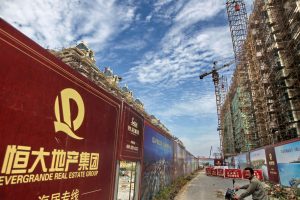The Diplomat author Mercy Kuo regularly engages subject-matter experts, policy practitioners, and strategic thinkers across the globe for their diverse insights into U.S. Asia policy. This conversation with Dr. David Yu – finance professor at NYU Shanghai and chairman of China Aviation Valuation Advisors – is the 292nd in “The Trans-Pacific View Insight Series.”
With impending debt default, how will restructuring of Evergrande impact ordinary Chinese citizen-investors?
As the debt default has not occurred, all we can do is look at it through a range of possibilities. As social stability is paramount, the authorities will be wary of any potential restructuring process that proves to be unwieldy, but it has to be balanced with more overarching risk adjustment affects while at the same time reining in of the velocity of credit expansion that can lead to more risk on the system.
The size of the company is large but not so systemic as some have argued. Thus a wholesale bailout is not likely to occur, but rather a more orderly centralized restructuring process will be needed given the large diverse placement of the assets of the group. Non-core and saleable assets will be sold and the remaining assets and projects will be segregated by regional divisions and projects somewhat like how the HNA Group restructuring has been carried out so far. There most likely will be “haircuts” especially on the group level.
What about the impact on local and regional governments?
There will be additional incentives for local and regional government interests to take over and finish up the projects as many regional lenders will have assisted in the direct financing of those particular projects and many local home purchasers have placed large advance purchase funds and await the delivery of those apartments. This segment has the most potential impact on ordinary citizens as the largest portion of people’s net worth is tied up in real estate. Similarly, concerning investor’s wealth management products, the risks are known and were offered at above-average lending rates compared to less risky products. Again, a wholesale bailout would not be effective to reprice risk but some floor compensation would be potentially be given. This repricing of risk has been slowly implemented throughout the entire credit spectrum as some firms have defaulted and entered the bankruptcy process.
What does the Evergrande crisis reveal about China’s over-leveraged real estate property industry?
This has shown a light on how aggressive and leveraged many real estate companies have become. The drive to be the biggest player with even larger returns required even more increased turnover of cashflow. There is a need to magnify their finite equity base, including the amplified bank financing and aggressive pace and payment percentage pre-sales on projects, so these additional cashflows can be used to invest in even more projects nationally and so forth. The key is the velocity of recycling these funds as quickly as possible. You can see how this can balloon quickly and become unwieldy as there may be little margin for risk mitigation as normally would be expected. In the future there will be more regulatory moves constraining some of the more aggressive financing maneuvers for this essential asset class.
Explain how China’s tightening regulatory controls affected Evergrande’s financial position.
There are many forms of tightening that are happening in the system. On the land sale side, there are more reforms here, some of which require additional capital that is needed to bid and shorten the time allowed for the start of development than previously allowed, among others. On the pre-sale side, this represents tighter restrictions on the amount of pre-sale and the pace of registration and the final transfer of new homes built to the buyer. Final registration and transfer of built homes enable the developer to obtain the remaining delivery cashflow payment due.
All of these worsen the cash position of the firm and decrease the velocity of funds that can be recycled for new projects. This slows down the entire business model and has created cashflow issues for developers that have not taken this into account. These are just some regulatory impacts.
How should U.S. and other foreign investors manage risk related to Evergrande?
The investors who have invested in Evergrande recently have known this is a high-yield credit and there are related risks. This didn’t just occur overnight. Even with this knowledge, many have invested despite wanting, in their minds, additional incremental risk-adjusted returns compared to the index. Some of these folks knew the risks while some others did not do as much due diligence. For those in it now, the main point is to understand their risk exposure and how best to contain this. For those who are interested in the workout process, they would need to get a solid understanding of the entire process as well as a holistic stakeholder analysis as the incentives are varied. Once it starts, this will not be a short process.

































